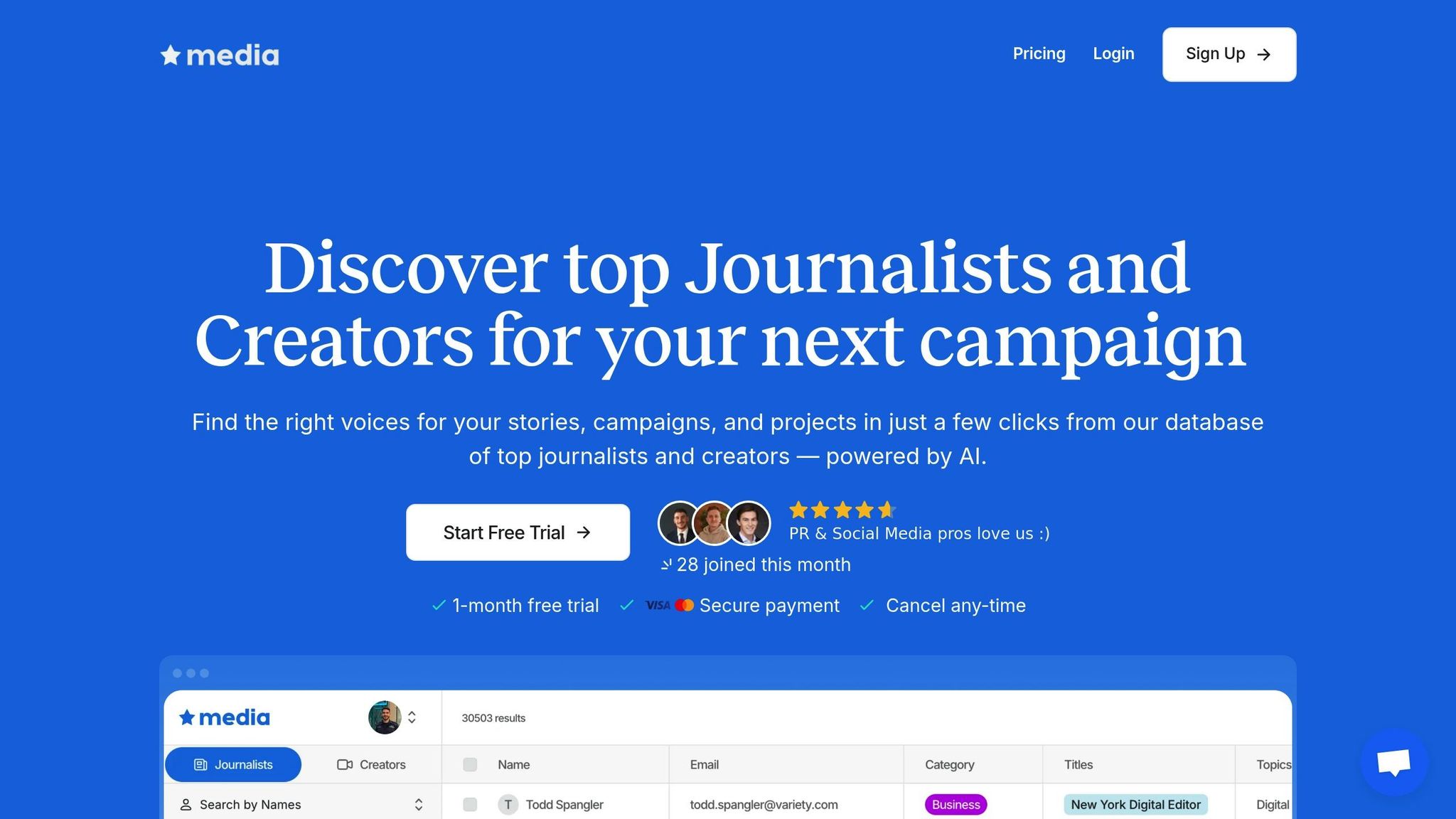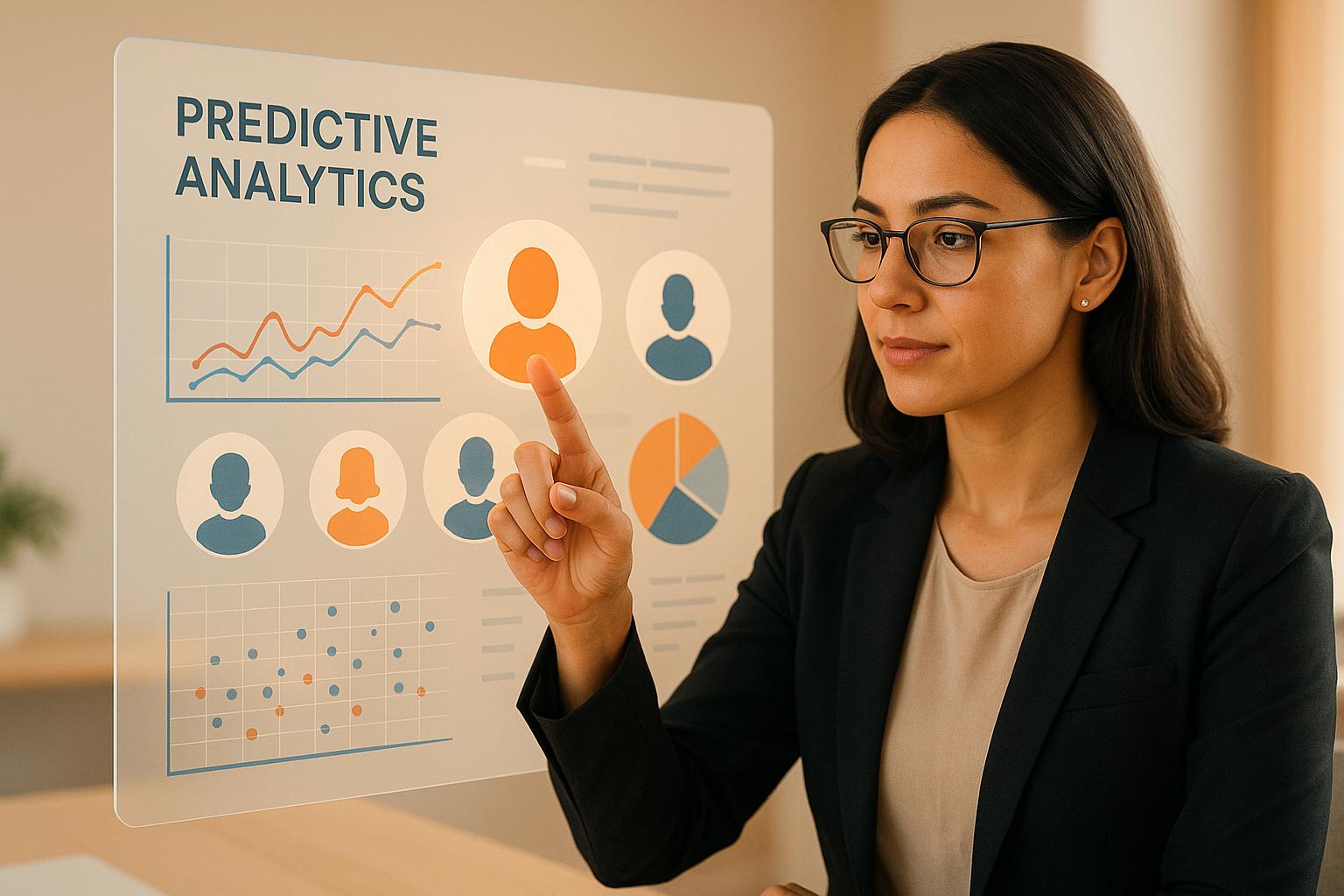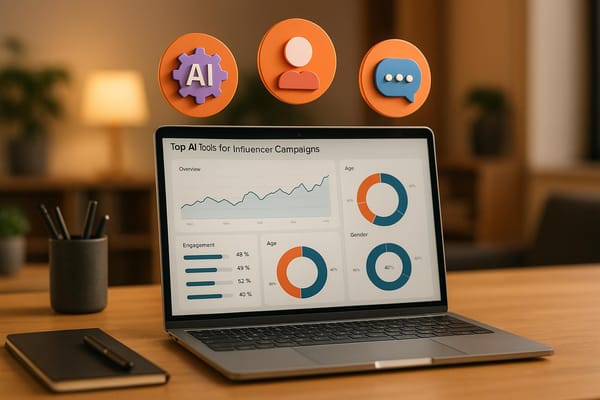AI Content Tools for Influencer Campaigns
Explore how AI tools are revolutionizing influencer marketing by enhancing efficiency, improving targeting, and ensuring content quality.

AI is transforming influencer marketing by solving long-standing challenges like finding the right creators, managing large-scale campaigns, and ensuring content quality. Instead of spending hours on manual tasks, brands can now use AI to:
- Identify ideal influencers: AI analyzes engagement, audience fit, and even detects fake followers.
- Streamline campaign management: Tools automate tracking, scheduling, and performance analysis.
- Optimize content: AI customizes messaging to suit different demographics and predicts what works best.
For example, platforms like Media AI simplify influencer discovery with a database of 30,000 creators and journalists, while offering affordable pricing plans starting at $99/month. AI doesn’t replace human creativity but enhances efficiency, helping brands run campaigns that connect better with audiences.
Influencer Marketing with AI: All You Need to Know
Common Problems in Influencer Campaigns
Despite advancements in technology, influencer marketing campaigns in the U.S. still face major hurdles due to outdated processes and scattered tools. Managing multiple creators and ensuring campaigns run smoothly often feels like trying to juggle too many moving parts without the right support.
Finding the Right Influencers
One of the biggest challenges in influencer marketing is choosing creators who genuinely fit your brand and audience. Many teams still rely on basic searches or directories that only scratch the surface, offering metrics like follower count and engagement rates. But those numbers rarely tell the full story.
It’s not just about picking someone popular. Brands need influencers whose audience aligns with their target market, whose content matches the brand’s tone, and who won’t spark issues down the line due to mismatched values or controversies.
Adding to the complexity, fake followers and engagement manipulation remain widespread. Some influencers inflate their stats with bots or engagement pods, making it hard to gauge their real impact. Without proper verification tools, brands often discover these issues too late - after the campaign has already underperformed.
Geographic targeting is another tricky area, especially for U.S.-focused campaigns. An influencer might boast impressive numbers overall but lack meaningful reach in key American markets. Similarly, an account appearing U.S.-centric might actually have followers concentrated in areas that don’t align with a brand’s goals or distribution strategy.
Even when the perfect influencers are identified, maintaining consistent and quality content is a whole other challenge.
Maintaining Content Quality
As influencer marketing grows, keeping content consistent and high-quality has become increasingly difficult. Each creator has their own style, schedule, and interpretation of the brand’s guidelines. While this individuality can be a strength, it often makes cohesive messaging across multiple influencers a tough goal.
AI-generated content is complicating things further. While AI tools help influencers create content faster, they sometimes result in generic posts that lack the personal touch audiences expect. This over-reliance on AI can water down the authenticity that makes influencer marketing effective in the first place.
On top of that, content approval processes are a frequent bottleneck. Long revision cycles, scattered feedback, and delays in communication can frustrate creators and derail timelines. Important updates may not reach all parties involved, leading to missed deadlines and inconsistent messaging.
Then there are brand safety concerns. Influencers might unintentionally use copyrighted music, include inappropriate elements in their content, or make claims that violate advertising regulations. Without a robust review system, these issues often come to light only after the content is live, leaving brands scrambling to address the fallout.
The stakes get even higher when campaigns involve managing a large number of influencers.
Managing Large-Scale Campaigns
When dozens - or even hundreds - of influencers are involved, manual management becomes unmanageable. Marketing teams often find themselves buried in spreadsheets, trying to track deliverables, payments, deadlines, and performance metrics across multiple platforms.
At this scale, communication breakdowns are almost inevitable. Different team members might give conflicting directions, and important updates can get lost in the shuffle. Coordinating with influencers across different time zones and platforms only adds to the chaos.
Tracking performance across large campaigns is another headache. Every platform has its own analytics, and influencers use various tracking methods. Consolidating all this data into actionable insights becomes a time-consuming task. By the time reports are ready, the campaign is often over, leaving no room for real-time adjustments.
Budget management also becomes a logistical nightmare. Influencers charge different rates, payment terms vary, and keeping tabs on actual spending versus the budget requires constant updates. Without automated tools, it’s easy for campaigns to go over budget or for payment delays to sour relationships with creators.
Ultimately, the sheer administrative workload of large-scale campaigns can overwhelm marketing teams, leaving little room for creativity or strategic thinking. Instead of focusing on building strong relationships with top creators, teams end up bogged down by logistics and paperwork.
How AI Solves Influencer Campaign Problems
AI is reshaping influencer marketing by streamlining tasks like content creation, trend analysis, and performance tracking. These tools not only save time but also uncover patterns and insights that might slip through the cracks when done manually. By addressing specific campaign needs, AI-driven solutions are transforming how brands approach influencer collaborations.
Automated Content Creation and Customization
AI simplifies content creation by generating tailored suggestions that align with each influencer's unique style. Advanced tools can analyze what resonates with different demographics and tweak messaging for various regions across the U.S. For example, AI might recommend using different hashtags for campaigns aimed at California audiences versus those in Texas. It can also adapt language to connect more effectively with Gen Z compared to millennials. These features directly tackle common challenges in influencer campaigns, like ensuring relevance and engagement.
Live Trend Analysis and Performance Predictions
AI tools monitor trends in real time, spotting emerging topics and viral moments across U.S. markets. This allows marketing teams to adjust strategies quickly. For instance, if a new meme or cultural event gains traction, brands can pivot their content almost immediately to stay relevant.
In addition, AI uses historical data to predict performance metrics like engagement rates, reach, and conversion potential. It considers factors such as posting time, content type, caption length, and hashtag usage. By automating these analyses, AI can cut the influencer vetting process by as much as 70%, enabling campaigns to launch faster. AI also identifies the best posting schedules for different audience segments by studying when target demographics are most active online.
Better Audience Targeting
AI goes beyond surface-level metrics like follower counts to refine audience targeting. It dives deep into data to identify who genuinely interacts with content, what topics spark interest, and how well an influencer’s audience aligns with a brand’s ideal customer base.
This precision is especially useful for finding high-performing micro-influencers. These niche creators often have engagement rates that surpass those of mega influencers. AI pinpoints these valuable collaborators by analyzing hashtags, keywords, and engagement trends, ensuring a stronger match between brands and influencers. Furthermore, AI can predict which influencers are most likely to convert their followers into customers based on past campaign data. By shifting the focus from vanity metrics to meaningful outcomes, AI helps brands achieve tangible business results. This sets the stage for tools like Media AI, which will be explored in the next sections.
Media AI: Simplifying Influencer Discovery and Collaboration

Finding the right influencers to amplify your brand can feel like searching for a needle in a haystack. That’s where Media AI steps in, combining a powerful database with user-friendly tools to make influencer selection and collaboration easier than ever. Let’s break down its standout features.
Extensive Creator and Journalist Database
Media AI boasts an impressive database of over 30,000 U.S.-based journalists and content creators. Each profile is packed with details, allowing users to filter by location, audience demographics, content focus, and engagement metrics. For instance, if a skincare brand wants to promote its launch in the Pacific Northwest, they can zero in on beauty influencers in Washington and Oregon who specialize in sustainable products. Plus, the platform ensures contact information is always up to date, so your outreach efforts connect with active creators.
Streamlined Campaign Planning and Execution
Managing influencer outreach can be overwhelming, but Media AI simplifies the process by consolidating everything into one workflow. Once you’ve identified the right collaborators, you can easily export contact lists directly into your PR tools. Its intuitive design caters to everyone - from solo entrepreneurs to large agencies - making research and outreach faster and more efficient.
Affordable, Flexible Pricing
Media AI offers straightforward pricing with no long-term commitments. The Journalist and Creators plans are $99/month each, while the Full Database plan costs $149/month. With no contracts required, businesses of all sizes can access these tools without feeling locked in.
Best Practices for Using AI in Influencer Campaigns
To make the most of AI tools in influencer campaigns, it’s essential to blend smart automation with a focus on genuine human connection. While AI can streamline processes, the heart of these campaigns lies in creativity and authenticity.
Balancing Automation with Human Touch
Influencer campaigns thrive on creativity and personal connection, but AI can handle the repetitive tasks that often consume valuable time. For instance, tools like Media AI can take care of research and identifying potential influencers, leaving you free to focus on crafting meaningful interactions. When reaching out, go beyond generic messages - reference specific posts or explain why their audience aligns with your brand’s goals.
AI can assist by drafting outreach emails or suggesting hashtags, but the influencer’s unique voice and storytelling are what truly engage their followers. To maintain this balance, set up a review process where AI-generated content is checked for brand alignment while preserving the influencer’s personality.
The best campaigns use AI to handle the groundwork - research, optimization, and analytics - while leaving creative decisions and final touches to humans. This combination ensures campaigns feel both efficient and personal.
Using Analytics for Better Results
Data is a game-changer in influencer marketing, and AI tools make it easier to uncover insights that might otherwise go unnoticed. However, the real value comes from interpreting these insights and acting on them wisely.
- Audience overlap analysis: When working with multiple influencers, AI can identify overlapping audience segments to help you maximize reach without unnecessary redundancy.
- Optimal posting strategies: AI pinpoints the best posting times, hashtag combinations, and content formats for your target audience, improving engagement and visibility.
- Real-time monitoring: Stay ahead of trends with AI-powered alerts, allowing you to tweak your strategy on the fly. This flexibility keeps campaigns relevant and in tune with audience preferences.
- Performance predictions: By analyzing historical data, AI can predict which influencer collaborations are likely to deliver the highest ROI. This insight helps allocate budgets effectively, ensuring you invest in partnerships that truly pay off.
With these tools, campaigns can be optimized for better outcomes, but it’s crucial to use AI responsibly and ethically.
Using AI Ethically and Transparently
Trust is the cornerstone of influencer marketing, and ethical AI use is key to maintaining that trust. Transparency about AI’s role in your campaigns not only builds credibility but also reinforces the authenticity that audiences expect.
If AI contributes to content creation - such as generating captions or suggesting topics - be upfront about it. Many audiences appreciate the innovation as long as it complements, rather than replaces, human creativity.
Ensure compliance with privacy regulations and regularly audit algorithms to prevent bias. Be transparent with influencer partners about how AI tools are used, particularly when analyzing audience demographics or engagement patterns.
Above all, prioritize content authenticity. AI should enhance human expression, not replace it. Establish clear guidelines to ensure AI-generated elements support, rather than overshadow, the genuine voices of influencers. This approach amplifies authenticity, keeping campaigns relatable and trustworthy.
Conclusion: What's Next for AI in Influencer Marketing
The landscape of influencer marketing is shifting rapidly, and AI is at the heart of this transformation. From tackling the challenge of finding the right creators to improving content performance and managing campaigns at scale, artificial intelligence has moved from being a buzzword to becoming a key component of modern marketing strategies. Long-standing hurdles in influencer campaigns are now being addressed with practical, AI-driven solutions.
Issues like inefficient creator discovery, inconsistent content quality, and the complexity of campaign management are no longer insurmountable. AI-powered platforms, such as Media AI, provide access to extensive databases of over 30,000 journalists and creators, simplifying the entire process - from discovery to collaboration - all while offering accessible pricing options.
Looking ahead, the role of AI in influencer marketing will only grow stronger. Tools offering real-time trend analysis and performance predictions are becoming the norm, enabling marketers to make faster, data-backed decisions. The ability to automate customization while maintaining authenticity is emerging as the sweet spot for successful campaigns.
The future of marketing is clear: AI tools are no longer optional - they’re a competitive advantage. Whether you’re a PR professional, a social media agency, a startup, or a freelancer, the opportunity to harness these tools for impactful results has never been more accessible.
However, success will favor brands that strike a balance - leveraging AI’s precision while maintaining authentic connections. By pairing AI’s capabilities with genuine storytelling, as discussed earlier, brands can foster meaningful engagement and stay ahead in this evolving space. AI isn’t just reshaping influencer marketing - it’s becoming the foundation for its future.
FAQs
How does AI help brands find influencers with real engagement instead of fake followers?
AI makes it easier to spot influencers who genuinely engage with their audience by analyzing important metrics like follower growth, engagement rates, and any unusual patterns that might suggest fake followers. For instance, sudden jumps in follower numbers or low engagement relative to follower count can serve as warning signs.
With the help of advanced machine learning, AI tools can identify and flag questionable activity. This allows brands to work with influencers who truly resonate with their audience, ensuring campaigns are more effective and deliver stronger returns by prioritizing genuine connections.
What are the risks of overusing AI-generated content in influencer marketing campaigns?
Over-relying on AI-generated content in influencer campaigns can create a few significant hurdles. For one, it often lacks the genuine emotions and personal connection that audiences expect from influencers. This absence of a human touch can make the content feel impersonal, leading to a decline in trust - both in the influencer and the brand they represent.
Another issue is the risk of producing generic or repetitive content. When AI dominates the creative process, campaigns can lose their distinctiveness, potentially damaging your brand's image. On top of that, there are ethical concerns to consider, such as the possibility of spreading misinformation or raising privacy issues, especially when AI tools rely on large amounts of personal data.
AI can undoubtedly boost efficiency, but blending it with human creativity and oversight is essential to keep your campaigns relatable, trustworthy, and impactful.
How can AI make managing large-scale influencer campaigns more efficient?
AI takes the hassle out of managing large-scale influencer campaigns by automating critical tasks like finding and evaluating influencers, fine-tuning content, and tracking performance metrics. This cuts down on manual work, saving both time and resources.
It also gives marketers real-time insights into influencer effectiveness, audience engagement, and sentiment analysis. These tools make targeting more accurate, helping campaigns grow efficiently while achieving stronger results. By handling repetitive tasks and improving decision-making, AI frees up teams to concentrate on strategy and creative ideas.





